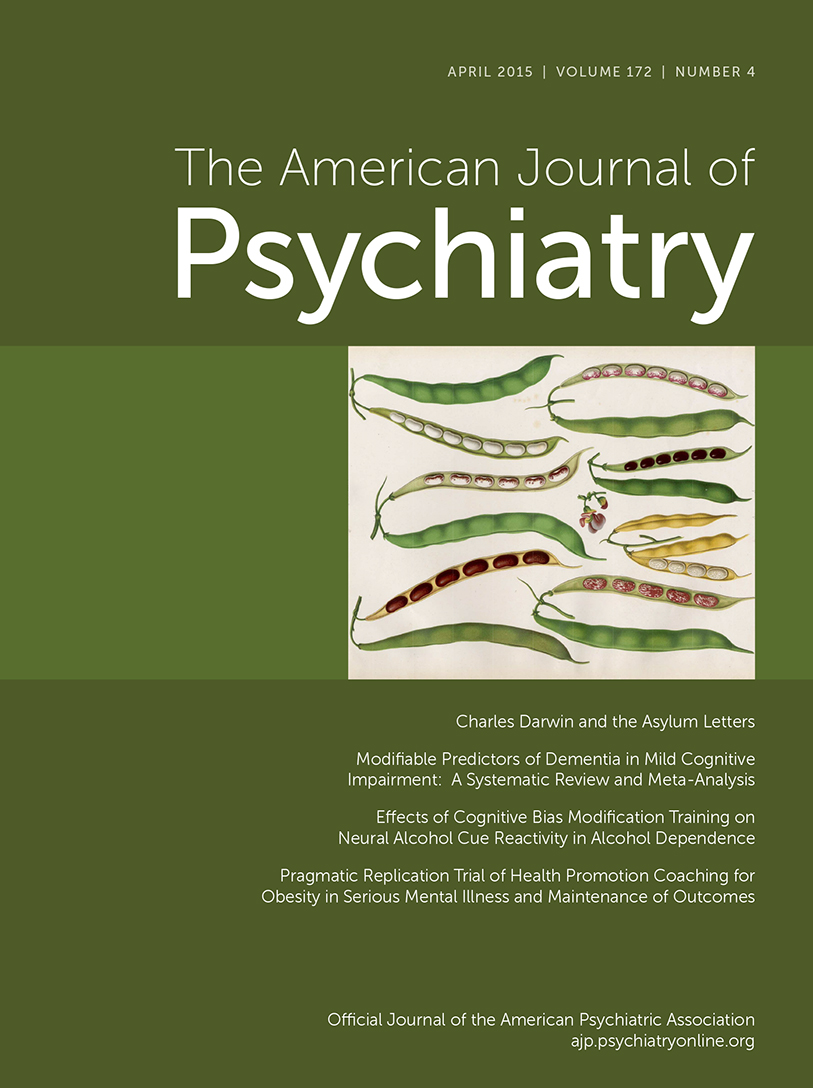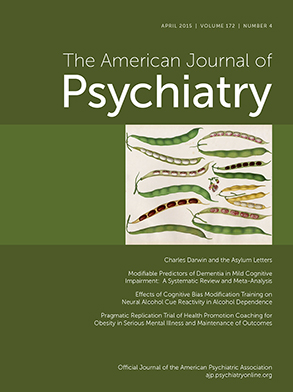Several stress-triggered conditions have been linked with systemic inflammation, with previous reports of elevation in plasma levels of the inflammation marker C-reactive protein (CRP) in association with childhood adversity (
1), depression (
2), and posttraumatic stress disorder (PTSD) (
3). In this issue, Michopoulos et al. (
4) examine whether single-nucleotide polymorphisms (SNPs) within the
CRP gene and elevated CRP levels are associated with PTSD symptoms and fear physiology in a poor, highly traumatized, primarily African American sample recruited from an inner-city public hospital. The authors found one SNP within the
CRP gene, rs1130864, to be associated with PTSD diagnosis and greater symptom severity—most significantly the symptoms of hyperarousal—in a sample of nearly 2,700 subjects. In a smaller subsample (fewer than 200 subjects) in whom plasma CRP levels were measured, this SNP was also associated with CRP levels, and high CRP levels (>3 mg/L) were positively associated with PTSD symptoms, greater odds of a PTSD diagnosis, and increased psychophysiological hyperarousal as determined by increased fear-potentiated startle. After thoughtfully discussing a number of caveats in interpretation of the data, the authors conclude that inflammation might be a target for PTSD therapeutics.
This elegant work, while highlighting a possibly important role for inflammation in PTSD, also illustrates the complexity of untangling the directionality of causal pathways underlying previously reported associations of cardiometabolic disorders and PTSD (
5,
6). Although directionality of association of elevated plasma CRP with PTSD cannot be inferred from Michopoulos and colleagues’ cross-sectional study, the observed association of CRP genotype with PTSD risk suggests a direct etiological link. A recent longitudinal study in U.S. Marines showed that higher predeployment CRP level was associated with greater risk for subsequent PTSD (
3). Despite the fact that the prospective nature of an observation diminishes the likelihood of reverse causality, it is nonetheless possible that one or more factors—environmental (e.g., smoking, obesity) and/or genetic—that increase CRP levels are also associated with increased PTSD risk, with no guarantee that CRP (as an index of inflammatory processes) plays a causal role in such a pathway. One way to disentangle cause and effect, once larger data sets are available, may be to apply Mendelian randomization analysis (
7). Mendelian randomization is a form of instrumental variable analysis that takes advantage of the fact that genes are randomly assorted from parents to offspring and, as such, are transmitted independently of confounding factors and cannot be subject to reverse causation (that is, germline genetic variants that influence CRP levels could cause PTSD but not vice versa) (
8).
An even greater challenge to the interpretation of the findings of Michopoulos et al. is the likely impact of unmeasured confounders. The authors note that they lacked information for their sample about comorbid medical illness and obesity (body mass index). The high CRP levels with large variation they report (mean=5.14, SD=4.77) may be due in part to a preponderance of individuals with inflammation attributable to chronic medical conditions (e.g., pulmonary, cardiovascular, metabolic), which are increased among those with PTSD (
9,
10). In addition, elevated CRP levels have been reported in depression (
2), and because comorbid depressive symptoms are not reported in the Michopoulos et al. study, it is not possible to tease out differential effects for depression and PTSD. But the question of specificity goes well beyond comorbidity with depression. A recent meta-analysis of 14,991 subjects spanning 36 samples found trauma exposure to be positively associated with proinflammatory markers, including CRP, interleukin (IL)-1β, IL-6, and tumor necrosis factor-α, across psychiatric diagnoses (
11). Future prospective studies comparing inflammatory profiles between subjects developing PTSD (
5), depression (
12), and other stress-related mental disorders—which should be stratified for prenatal and postnatal early adversity (
13)—may permit directional and perhaps causal inferences about proinflammatory mechanisms underlying the elevated physical morbidity and mortality observed with these disorders.
Validating a direct causal genetic association would implicate an immune/inflammatory mechanism in PTSD pathogenesis. However, even if CRP elevation is secondary, it may represent an important potential prognostic marker and therapeutic target. Looking at the cardiovascular literature may prove instructive: Patient-level meta-analysis demonstrates continuous associations of plasma CRP concentration with risk for both vascular and nonvascular conditions, including coronary heart disease, ischemic stroke, and death from several types of cancer and lung disease, with considerable dependence on the level of other conventional risk factors and other markers of inflammation (
14). Several meta-analyses and prospective studies have implicated elevated CRP levels with increased coronary heart disease risk (
15). However, such correlations cannot tease apart a causal role for CRP (related either to chronic mild inflammation or to an increase in inflammation during episodes of acute myocardial infarct formation) from confounding by associated reasons for its rise.
CRP is a nonspecific, highly sensitive pentraxin protein marker of systemic inflammation. In acute-phase reactions (e.g., infection or tissue injury), CRP may rise transiently more than 1,000-fold within hours, but its levels may show mild chronic elevations in conditions associated with low-grade chronic inflammation, such as obesity, metabolic syndrome, type II diabetes, depression, and PTSD. Its level is mainly determined by the rate of hepatic synthesis, under transcriptional control primarily by IL-6 (
16). IL-6 is a proinflammatory cytokine secreted by activated T cells, macrophages, and adipocytes, and it constitutes the major transcriptional stimulus for the production of CRP by liver cells. IL-6 secretion is induced by acute infections, chronic inflammatory conditions, obesity, and, notably, acute psychological stress (
17). Elevated IL-6 sensitivity to anticipation and to negative emotions, and higher salivary IL-6R levels, have been reported to differentiate persistent and remitted PTSD patients (
18). Taking these very preliminary observations into consideration, CRP may well be a biomarker for PTSD (and many other chronic, stress-exacerbated conditions), but IL-6 may be a more critical molecular target for future therapeutics.
The importance of this line of research ultimately hinges on what it can tell us about treatment. Elevated CRP levels constitute a stress diathesis marker at the crossroads of maladaptive behavioral and cardiometabolic sequelae. Can our current knowledge about CRP levels be used to guide clinical decision making for PTSD and depression? At this stage, definitely not. Prospective studies employing inflammation level markers as intermediate outcome measures alongside self-reported symptom scores will provide traction as we seek to disentangle cause from effect, and confounder from target. However, regardless of cause-and-effect relationships or even a specific effect on psychiatric symptoms (
19,
20), reducing stress-related inflammation may diminish the adverse cardiometabolic impact associated with PTSD (
5) and depression (
12). For example, although CRP elevation may be secondary in determining cardiovascular prognosis (
7), the prospective JUPITER trial (“Justification for the Use of Statins in Primary Prevention: An Intervention Trial Evaluating Rosuvastatin”) demonstrated that statin therapy initiated before cardiovascular disease is diagnosed cuts in half prospective heart attack and stroke risk (
15), with the risk reduction attributable to baseline CRP rather than LDL level, suggestive of an anti-inflammatory protective mechanism for statins. Inflammation biomarkers may similarly provide objective markers for premorbid diathesis, course and prognosis, and treatment outcome for stress-related psychiatric disorders alongside traditionally employed measures of functional impairment and subjective suffering. From these promising initial stages, one can envisage the use of mechanistically relevant prognostic biomarkers, as well as preventive and palliative treatment endpoint indicators, pushing mental health treatment into the era of precision medicine.

